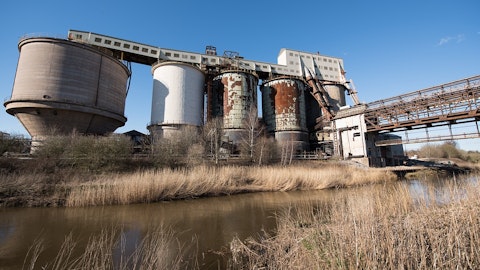Steve Bender: It’s actually well across the portfolio, everything from procurement opportunities in both PEM and in HIP as well as logistics opportunities. So it really is across both segments roughly, let’s say, equally so.
Operator: Our next question comes from the line of Aleksey Yefremov from KeyBanc Capital Markets.
Unidentified Analyst: Great. This is Ryan on for Aleksey. Thanks for taking my question. My first question would be around current dynamics in chlor-alkali. Have recent capacity reductions by some of your peers had a positive impact on the market thus far? And are there any areas like where you’re seeing incremental demand for your product?
Albert Chao: Yes. As we know that chlorine, the biggest use of chlorine is for PVC and the biggest user of PVC is construction. And as Steve mentioned, not only we are impacted by the high interest rate, high mortgage rate impacted affordability on new housings and also on the repair/remodeling activities, but also seasonality is impacting it. So, I think the operating rate tends to go down for both PVC and for chlorine and chlor-alkali especially in the fourth quarter and maybe even part of the first quarter.
Unidentified Analyst: Helpful. Thank you. And then, can you just talk about what you’re seeing in the epoxy market? It seems like there might have been some stability in prices here in October, albeit it’s at a low level, and it seems like costs are kind of continuing to get at margins. Just any commentary you can give us there would be much appreciated.
Albert Chao: Yes. As Steve mentioned, that our epoxy business is impacted by imports, both Asian imports to Europe and Asian imports to U.S. And the prices both in Europe and U.S. have dropped and very close now to the imported price. So we see some stability even though the margin is pretty poor.
Operator: Our next question comes from the line of Bhavesh Lodaya from BMO Capital Markets.
Bhavesh Lodaya: Yes, this is Bhavesh for John. Good morning, Albert and Steve. Congrats on the quarter and the continued outperformance on the HIP segment. If I compare your performance in HIP this year versus last, during the quarter, so volumes are roughly flat, and your margins are up 8% year-over-year. Is that all price versus cost, or is there an element of changes in the product mix of what you are selling?
Steve Bender: No. So when you think about year-over-year results, of course, you’re right, volumes are flat, but I would say that given the headwinds we’ve seen related to affordability driven by higher rates, it really is, I think, a testament to the strength of the portfolio offered. Obviously, we’ve seen some pressure on price, either quarter-over-quarter or year-over-year. But nevertheless, I think the strength relative to the year-over-year with ‘22 a much stronger year than ‘23 is a testament to really the strength that we have with our customers and the offerings that HIP does provide. I think if you think about the performance we had quarter-over-quarter, a nice pickup in volume of 7% from 2Q to 3Q, which tells you even in this market that we’ve seen, we’re right where rates are at 8%-plus from 30-year mortgages, still strong performance from a volume perspective in the portfolio in our HIP business.
Bhavesh Lodaya: Got it. And then, a question on the PE markets here. So, we have seen international prices move higher in line with the feedstocks and pretty heavy volumes going from the U.S. into exports in general. How do you see the mix going ahead? And any color on your outlook for PE pricing here?
Albert Chao: Yes. The U.S. industry is exporting in the high-40-odd percent in polyethylene. And with new additional capacity coming up, U.S. local demand, domestic demand cannot absorb the capacities. So, I think as the new capacity comes up, more export, more volume will be exported, which has come to a lower price, of course.
Operator: Our next question comes from the line of Matthew Blair from TPH.
Matthew Blair: With $3.1 billion of cash, could you assess the M&A landscape? What kind of areas would you be interested in adding in? And is it fair to think that if you did make an acquisition it’s more likely that would be in HIP than PEM?




